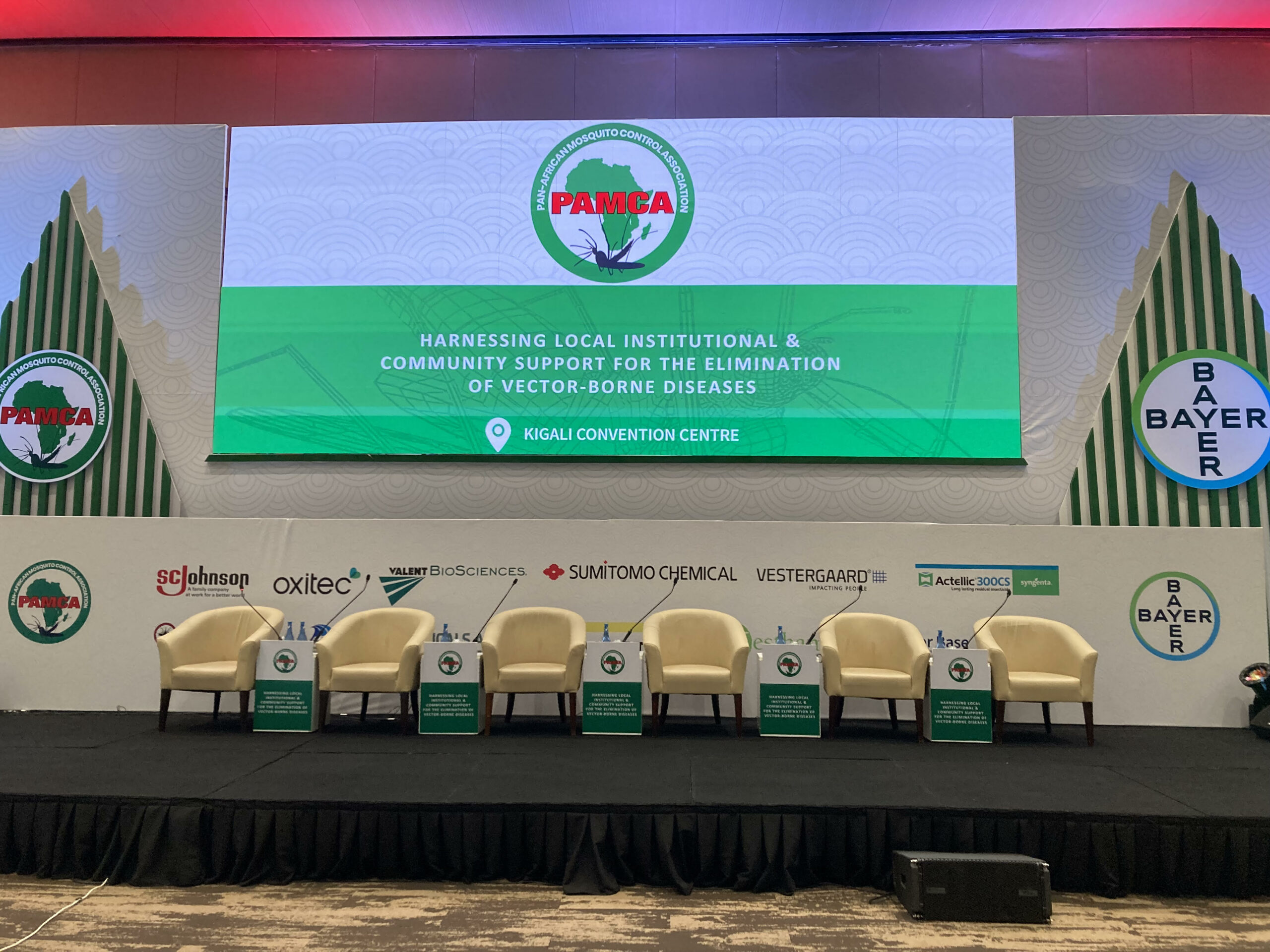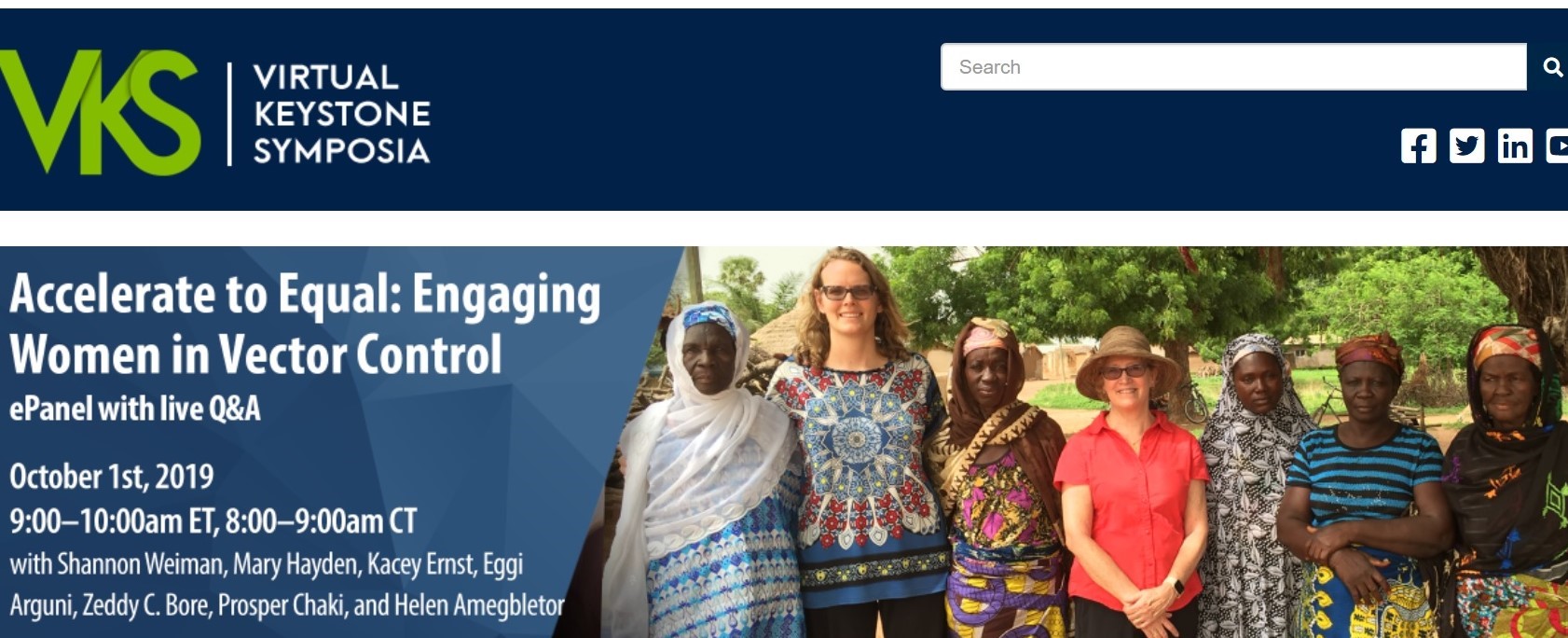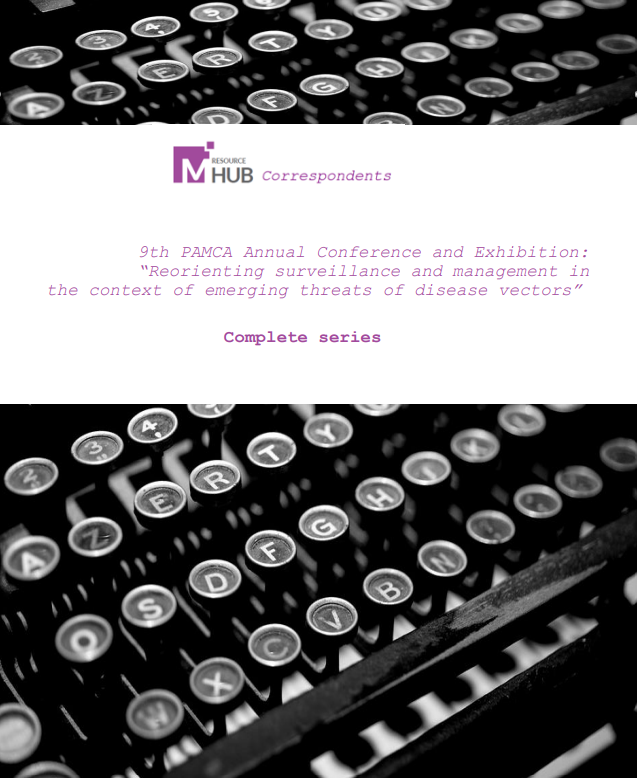8th PAMCA Annual Conference and Exhibition: Day 2
Tuesday, 27th September 2022
Published: 04/10/2022
This report is brought to you by the MESA Correspondents Lambert Nzungize, Eggrey Aisha Kambewa, Oyinkansola Suliat Fadiji, Jean Claude Ngirimana, Diane Leslie Nkahe, Mauro Pazmino Betancourth, Patricia Doumbe Belisse, Nathalie Amvongo Adjia, Otubea Owusu Akrofi, and Caroline Kiuru. Senior editorial support has been facilitated by Jessy Goupeyou-Youmsi and Idelphonse Bonaventure Ahogni.
THEMES: THEMES: Vector Control
MESA Correspondents bring you cutting-edge coverage from the 8th PAMCA Annual Conference and Exhibition “Harnessing local institutional and community support for the elimination of vector-borne diseases (VBDs)”.
Day 2: Tuesday, 27th September 2022
Plenary talks 1 to 4:
Corine Karema (Roll Back Malaria – RBM) began her presentation by pointing out the importance of data in decision-making and collaboration among different entities. For example, she mentioned that RBM has collaborations with governments, NGOs and donors. According to WHO, Africa has the majority of malaria cases. The challenges are low malaria intervention coverage during the pandemic, insecticide resistance, funding gap, Ebola, and flooding among others. She then pondered what was required to get back on track. Around 10 billion USD per year, new tools, and sharing experience. In terms of data decision-making, she asks herself, “Why does malaria response require the use of data?”. To answer this she gave two clear examples where data is used, in health management information systems (HMIS) and district health information software (DHS2). In the end, Krema emphasized the role of PAMCA in demonstrating the type of insecticide required, the use of data for decision-making, data sharing, and empowering women in vector control.
Heather Ferguson (Glasgow University, UK) presented the effects of climate change on malaria vector control. Africa is the most vulnerable continent as it is warming faster than the rest of the world. Climate change might cause the re-emergence of malaria, increased transmission at higher altitudes, changes in vector ecology and human behavior. This will test the efficacy of current interventions and the question will be on how to adapt interventions to changes. Outbreaks of various diseases might limit the funding for malaria research. There is a need to identify the environmental determinants of intervention efficacy and feasibility and investment in climate robust strategies.
Mark Latham (PAMCA and IVCC) initiated his presentation on larval source management (LMS) in operational mosquito control programs: lessons from the past and tools for the future. He began by demonstrating how vector control programs in the USA are mostly at the local level, but never one size fits all. Vector control programs’ decentralization increased their complexity and capability. Furthermore, vector control in the United States focuses heavily on nuisance species. As a result of targeting multiple mosquito species, the success is based on entomological evidence. He also stated that the vector control program in the United States focuses on larval and adult surveillance, larvicide, and biological control. The advantage of larva surveillance helps to identify species, habitats, bionomics, seasonality, and flight range. Thus, it is preferable, to begin with, boots on the ground to assess larva presence density, then use a GIS database to identify existing larva sites, record them, and save them for future intervention. Many tools are available, including Google Earth, imagery, and LIDAR. He explained that in the selection of larvicide products, previous evidence can help to make a choice of the right larvicide, searching in published articles, knowledge exchange, keep communicating with neighbors, wing beats (magazine), after all, you can select your larvicide product, and the cost is also an important factor. The application also necessitates careful consideration because not all sizes fit all, whether done by hand, by vehicle, with a coarse droplet of larvicide, a tank sprayer, or by aerial such as drones or helicopters. As a result, the quality of the application is critical; otherwise, you’re wasting money and time. Therefore, post-application monitoring and evaluation provide evidence to support the next application strategy. He concluded that accurate surveillance requires a lot of attention.
Marion Law (WHO, Switzerland) introduced us to the steps, committees and working groups involved in the evaluation of vector control products. Emphasis was on safety, quality and efficacy to which she added timely access as part of lessons learnt. Further down in her presentation, she expressed how they needed to build infrastructures in order to properly manage data and how they came up with a consistent evaluation approach. According to her, “the primary output of the evaluation process is good, robust decision making”. To conclude, emphasis was made on equality as regards the importance of all aspects which is provided in the assessment report.
Parallel Scientific Session 5: Larval source management and integrated vector management
Antonio-Nkondjio Christophe (Organization for coordination for the fight against endemic diseases in Central Africa – OCEAC, Cameroon) highlighted that WHO promotes the use of interventions alone or in combination in order to efficiently manage insecticide resistance and control vector-borne diseases (VBDs). The study was conducted for 2 years in the city of Yaoundé, Cameroon, on behalf of its characteristics suitable for practicing larviciding. The baseline data helped to separate the 13 intervention areas from the 13 non-intervention areas. Larval and adult collections were performed before and during the larviciding to assess the mosquito distribution. The biolarvicide VectoMax G has been applied according to the manufacturer’s instructions every 14 days. This study showed a monthly variation in breeding sites and adult mosquitos’ distribution across the city following the implementation of larviciding. The malaria prevalence in intervention sites was reduced.
Nkahe Diane (University of Yaoundé I, Cameroon) started by mentioning that the impact of larviciding on insecticide resistance prevalence remains unknown. The insecticide resistance level of An. coluzzii to deltamethrin and the fitness parameters were assessed before and after larviciding using bioassays, qPCR and Multiplex detox assays, in order to check some insecticide resistance reversal patterns both in the field and in laboratory strains. Despite the significant increase in the susceptibility to deltamethrin in laboratory strains, the resistance level remained high in the field mosquitoes. The frequency of the kdr gene (L1014F) and the expression level of GsTe2 and Cyp6P3 remained high irrespective of the generation, and selection regime. The life traits were very different from one strain to another.
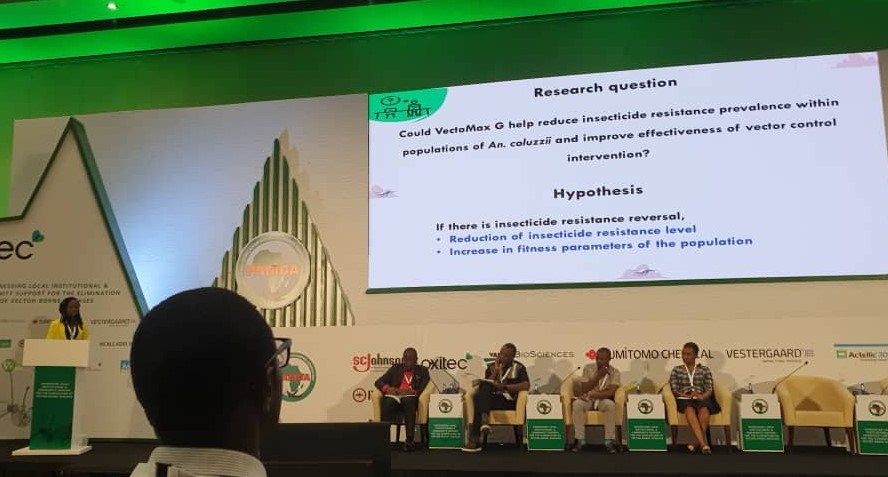
Jubilate Mina (National Malaria Control Program – Tanzania) stated that the Tanzanian government prioritized the control of mosquitoes’ aquatic stages since it reduces larval density and adult mosquitoes, hence, contributing to the reduction of malaria transmission. The biolarvicide BACTIVEC and GRISELESF locally manufactured have been applied since February 2022 based on the rainfall pattern and malaria risk strata. Six larval source management (LSM) SOPs have been developed, and six types of training on biolarvicing have been organized at the Ward village at the community level. A baseline larval habitat has been established and the quantity of larvicide/surface was defined. The project by the Swiss Development Cooperation in Tanzania will last 4 years and is still ongoing.
Doumbe Belisse (University of Yaoundé I, Cameroon) talked about the impact of a biolarvicide (VectoMax G) on malaria prevalence in the city of Yaoundé. Parasitological survey was conducted to get parasitological indicators, mostly malaria prevalence in 26 areas. Before that, cluster randomization was performed to select intervention and non-intervention areas. Then malaria prevalence was recorded in both types of areas and compared according to population characteristics. The study highlighted a high prevalence in non-intervention areas compared to intervention areas whatever the age range, sex, the frequency of long-lasting insecticide-treated nets (LLINs) usage and the diagnostic tools (RDTs, microscopy or PCR).
Carmène Ngadjeu (University of Yaoundé I, Cameroon) talked about the influence of house characteristics on mosquito distribution and malaria transmission during a larviciding trial in the city of Yaoundé, Cameroon. She demonstrated that non-protective features of houses like the absence of screens on windows, and the presence of holes in the wall and opened eaves, increased the risk of exposure to mosquito bites contrary to close eaves and ceilings at an instance. The study also highlighted a high risk of malaria infection in traditional houses compared to modern homes.
Steven Gowelo (University of Malawi, Malawi) highlighted the masked contribution of LSM in malaria control in the context of high insecticide-treated bed nets (ITNs) use. LSM’s intervention used in the study as draining, filing and spraying Bti coupled with house improvement, affects the outdoor densities of Anopheles arabiensis, a major malaria vector in Malawi. He also stated that there was a high coverage of mosquito nets in the area but there were challenges around the LSM implementation and house improvement.
Parallel Scientific Session 6 – LLINS, IRS and Insecticide Resistance Management
Maria Pondja (National Malaria Control Programme – NMCP, Mozambique) presented the results of a study monitoring insecticide resistance in the main malaria vectors across Mozambique. The study reported resistance to deltamethrin, alphacypermethrin, permethrin, lambda-cyhalothrin, DDT and bendiocarb. Furthermore, that pre-exposure to piperonyl butoxide (PBO) restored susceptibility to deltamethrin confirming the involvement of metabolic resistance. She concluded the talk by highlighting that the widespread insecticide resistance observed in malaria vectors in Mozambique poses a huge threat to malaria control and elimination efforts.
Parallel Scientific Session 7: New and re-emerging arthropod-borne viruses, climate change, NTDs and One Health
Remy Hoek Spaans (Liverpool School of Tropical Medicine – LSTM, UK) et. al researched the differences among various models and the impact on malaria using climate simulation data. To achieve this, collaboration was forged between South Africa and the UK institutions leaning on the knowledge of climate scientists, and malaria knowledge from her team. Results showed that conversion permitting climate data simulation (CP4) has better agreement with observed data. However, some things are still considered a work in progress owing largely to the parameters used which were skewed. To conclude, she emphasised the need to continue entomological research on the climate suitability of different mosquito species.
Parallel Scientific Session 8: Vector biology, ecology, taxonomy and population genetics
Diego Ayala (Institute of Research for Development – IRD, France) started his presentation by asking how we can predict the urban adaptation of Anopheles gambiae and An. coluzzii, vectors in Central Africa. Malaria cases have been higher in rural areas since 2000, however, after 20 years, there were malaria cases also recorded in urban regions. In this study, he characterized 380 breeding sites and genotyped 2427 mosquitoes in Douala, Bangui, Libreville and Brazzavill. The study revealed high variability in physical-chemical parameters across breeding sites, but they are similar across the cities. Anopheles coluzzii is predominant in coastal cities and it is adapted to high ammonium concentration. However, An. gambiae, which is predominant in savanna, is tolerant to high salt concentrations. Both species showed high levels of adaptation to urban settings. Due to the high levels of urbanization that Africa will experience by 2035, malaria-related deaths will increase if there are no control measures taken in cities.
Marianne Sinka (University of Oxford, UK) presented to us the international project called “Vector Atlas”. She explained how occurrence data for malaria vectors was hard to find. Data is scattered in the scientific literature, and it is not always available. The aim of Vector Atlas is to have all this information about principal and secondary malaria vectors in one place. Moreover, Vector Atlas includes information such as bionomics, house type and fauna/ flora which is useful to understand the ecology of Anopheles mosquitoes. The website interface allows us to select what type of map we want, download it, and submit data as well. Current work is focused on updating maps and transforming the data into useful formats. The project will help researchers and policymakers by making data easy to access.
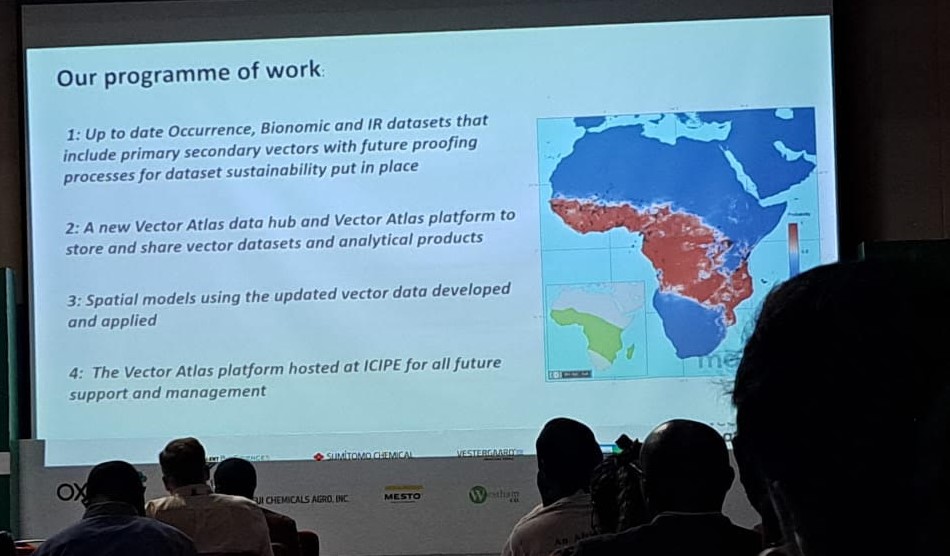
Roundtable Discussion 1 & 2:
Harnessing the capacity of the African institution for strengthened response against vector-borne diseases (VBDs)
This session was chaired by Prosper Chaki (PAMCA) and Emma Orefuwa (PAMCA).
Diabate Abdoulaye (Research Institute of Health Sciences – IRSS, Burkina Faso) opined on the standard of living and infrastructure as part of the factors for brain drain experienced across Africa. Speaking on inclusive leadership, he strongly believes it begins with hiring candidates with the most passion for science. He also narrated how he prefers to take a passenger role in leading in order that individual excellence may shine.
Jewelna Akorli (Noguchi Memorial Institute for Medical Research – NMIMR, University of Ghana) returned to her home after her studies abroad to make an impact. For takeaways directed at women researchers, she surmised on mentoring and collaboration
Sam Kariuki (KEMRI, Kenya) responded to the question of funding and relevance by asking, “Who sets our research agenda?” He warned against the use of technologies that do not optimize local solutions and described how his institution has benefited from an approved collaboration and publishing policy when asked about collaborations.
Noella Bigirimana (Rwanda Biomedical Center – RBC, Rwanda) explained the importance of setting an in-house pace, impact-wise, prior to collaborations as a means of filtering parasitic collaborations. For takeaways, she put the responsibility of levelling the playing field on male researchers.
Gerry Killeen (University of Cork, Ireland) speaking on inclusive leadership added that motivation and value cannot be taught at the individual level and gave insights as to how no one has all the answers and how patriarchy stifles growth in research. He ended by warning about the pseudo capacity building where half-baked graduates are presented to the world.
Corine Karema (Roll back Malaria) talked about finding your support system and intentionality across the board in answering questions about motivation and navigating the murky waters.
The development journeys of global women leaders in vectors control and men allies
This session was chaired by Damaris Matoke, Jessy Goupeyou-Youmsi, Rosalia Joseph and Christina Sudi.
The panellists included Sheila Tlou (African Leaders Malaria Alliance – ALMA, Botswana), Corine Karema (Roll Back Malaria – RBM, Rwanda), Corine Ngufor (London School of Hygiene and Tropical Medicine – LSHTM, UK), Heather Ferguson (University of Glasgow, UK), Evelyn Olanga (PMI Kinga Malaria, Kenya) and Francesco Baldini (University of Glasgow, UK). The discussion covered two topics: people who played significant roles in women’s career and personal development and defining the term male ally and the role they play in helping women in spaces occupied majorly by men.
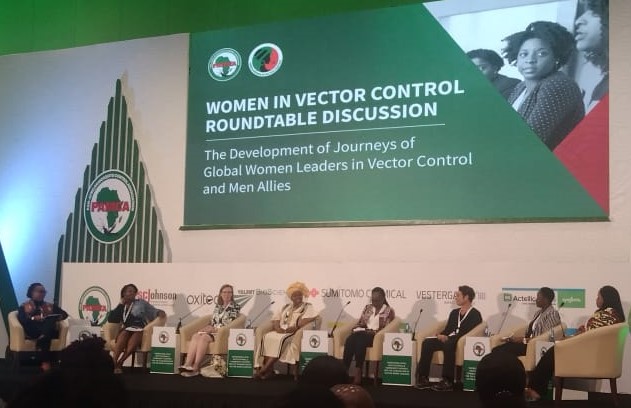
Q) What are the differences in leadership in different contexts?
Leadership can be inborn, being able to naturally take charge of any situation due to one’s ability to work and collaborate with other people. Leadership can also be a process a person can learn over time. This can be done by gaining knowledge and being a mentor to colleagues. Knowledge is power and how you use that power sets you apart. To be a leader, you need to be able to define yourself and have confidence in decision-making.
Q) How have women been able to reconcile to always prove themselves in places occupied by men?
It is difficult to be a leader in an area mainly occupied by men as they tend to second guess women’s decisions, look at their male counterparts for decision making and be challenged by superiors. It is important for women to network and empowers other women in similar situations.
Q) What helped women succeed in a male-dominated field?
First of all, misconceptions that certain fields of work are disliked by women need to be removed. For one to succeed in anything, passion is needed. Communication skills are important in enhancing careers. It is important for people to treat themselves as a brand so that they can be able to sell their skills.
Q) Who played important roles in your career development?
Families have played a huge role in encouraging women to achieve their goals, in not putting ceilings on their career goals. Female and male supervisors have provided mentorship and given opportunities to their mentees to achieve their goals. Opportunities given to women in the global North and South differ, women from the global North are given more opportunities, resources and support than women from the global South. There are still systematic biases that need to be tackled so all women are given the same opportunities.
Q) Why is it important to engage young people in decision-making?
Young people are the consumables of all decisions to be made therefore, they deserve a seat at the table. Youth have a lot of growth and act as role models in their communities and evidence shows that the more people at the decision-making table, the better and more inclusive the decisions are.
Q) What does it mean to be a male ally?
Being a male ally is to first acknowledge male privilege and the challenge women face in spaces majorly occupied by men. Acknowledging and having empathy for the plight of women is not enough, action, such as capacity building, mentorship, giving opportunities and creating positions for deserving women are needed.
This report is brought to you by the MESA Correspondents Nzungize Lambert, Eggrey Aisha Kambewa, Oyinkansola Fadiji and Jean Claude Ngirimana, with the support of the past correspondents Leslie Diane Nkahe, Mauro Pazmino Betancourth, Doumbe Belisse Patricia and Nathalie Amvongo-Adjia, and other volunteers Otubea Owusu Akrofi and Caroline Kiuru. Senior editorial support has been facilitated by Jessy Goupeyou-Youmsi and Idelphonse Bonaventure Ahogni.
Published: 04/10/2022
This report is brought to you by the MESA Correspondents Lambert Nzungize, Eggrey Aisha Kambewa, Oyinkansola Suliat Fadiji, Jean Claude Ngirimana, Diane Leslie Nkahe, Mauro Pazmino Betancourth, Patricia Doumbe Belisse, Nathalie Amvongo Adjia, Otubea Owusu Akrofi, and Caroline Kiuru. Senior editorial support has been facilitated by Jessy Goupeyou-Youmsi and Idelphonse Bonaventure Ahogni.
THEMES: Vector Control
